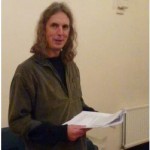 On 12th November, Dominic Upton gave a talk on Homeopathy at the Waverley Dowsers meeting. Dominic talked about the history of Homeopathy as well as providing some treatments for some common ailments Below is a summary of his interesting talk.
On 12th November, Dominic Upton gave a talk on Homeopathy at the Waverley Dowsers meeting. Dominic talked about the history of Homeopathy as well as providing some treatments for some common ailments Below is a summary of his interesting talk.
Hippocrates, over 2000 years ago wrote that there were two approaches to healing:
(i) the use of contraries (Antipathic medicine) or
(ii) similars (Homeopathic medicine).
Antipathy uses the opposite suffering to try to restore the body to health.
Homoeopathy uses similar suffering to restore health.
One common hay fever remedy is prepared from Allium cepa (onion) because a healthy person chopping an onion will often get a runny nose and streaming eyes.
Angry red swellings (however caused) may be treated with Apis (made from bee sting).
Blood poisoning may be treated with Lachesis, or other remedies made from snake venoms.
In the early 16th century a German doctor named Paracelsus, now known as the father of chemistry, strongly criticized the use of contraries and stressed his belief that like cures like.
However, it was not until the late 18th century that Homoeopathy as it is known today emerged. It came about when another German doctor, called Hahnemann, began to experiment.
He found that if healthy people took a particular substance and recorded their symptoms, then somebody suffering from similar symptoms could be cured using that substance.
He tried diluting the substances, often to the point where there wasn’t a single molecule of the original substance left, and with a test tube of the diluted substance in his hand, hitting it against a leather-bound Bible. He discovered that the process of shaking and bashing somehow imprinted the energy of the original substance into the liquid /dilutant so that it continued to have a medicinal effect, but the toxic effects disappeared during the dilution process.
Hering’s observations on the Direction of a Cure.
Symptoms move from above to below (head to toe). This is especially true of superficial symptoms related to skin; muscles; joints.
Symptoms move from within to without (from deeper tissue/organs to the surface)
Old symptoms reappear in reverse order.
Shortly after Hahnemann died, aged 88, the American James Tyler Kent was born. He had trained in orthodox medicine, but was converted to Homoeopathy by his first wife.
Many different substances had been proved (tested) and the symptoms they produced had been recorded in great detail. The information was written, usually in short essay form, called Materia Medica. The homeopath matches the symptoms of the patient as closely as possible to the symptoms each particular substance can produce. A book of symptoms (or Repertory) organized in a clear, logical way, enables a homeopath to look up symptoms to find the names of potential medicines and from there go to the Materia Medica for greater detail and to make a selection of the required treatments, Kent’s Repertory is still in wide-spread use today.
We thank Dominic for a great talk about Homeopathy with some very interesting insights dispensed to the keen audience.
Like this:
Like Loading...

You must be logged in to post a comment.